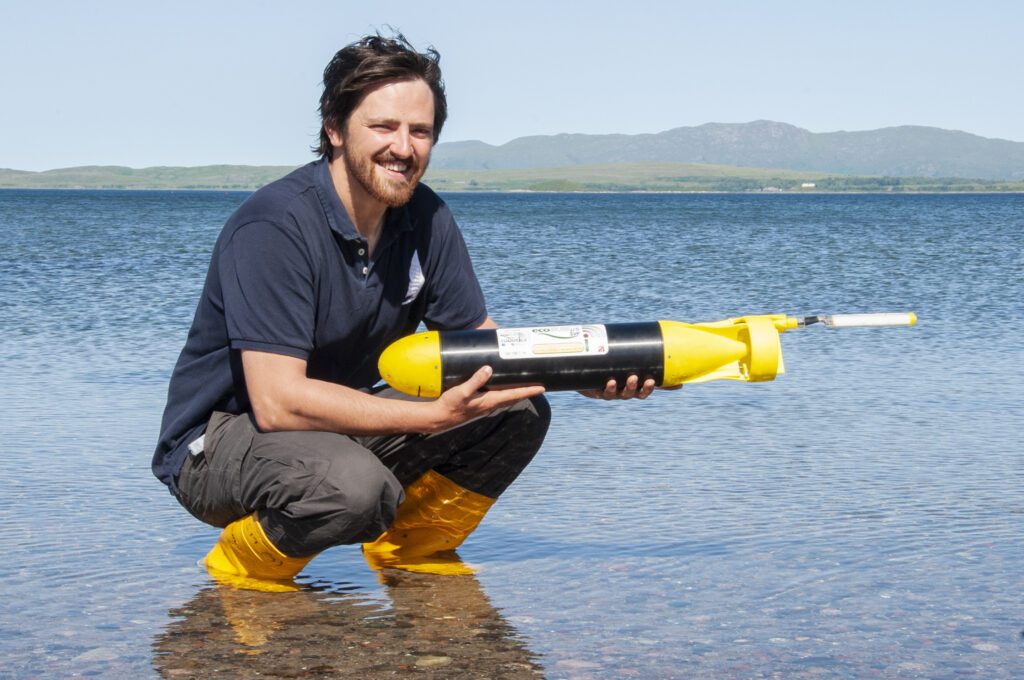Photo: Scottish Association for Marine Science (SAMS UHI).
Marine robotics to help uncover hidden link in glacier melting
By Karine Nigar Aarskog, UiT The Arctic University of Norway
Robotic vehicles will help scientists find the answers to how glaciers in Svalbard are melting. Friday, marine scientists started a new mission operated from Ny-Ålesund research station.
The purpose of the mission, who is a part of the project Fjordic Freshwater Fluxes, is to examine the Kronebreen glacier in Kongsfjorden, measuring the freshwater run-off as it melts, and assessing how it interacts with the saltier sea water coming into the fjord from the North Atlantic. The mission is a collaboration between the Scottish Association for Marine Science (SAMS), UiT The Arctic University of Norway, the Norwegian Polar Institute and University Centre on Svalbard.
“Fjords are the connection between the changing ocean and our rapidly melting northern glaciers. The transfer of heat and water at these points, often just a few kilometres wide, are therefore extremely important in understanding how climate change is impacting our ocean”, said lead scientist Prof Finlo Cottier of SAMS, who is also professor II at UiT.

Humans are unable to sample at the glacier face because of the risk of huge chunks of ice collapsing into the sea below, a process known as glacier calving.
As these areas are too dangerous to survey fully and too small to be picked up on global ocean models, the interactions between fjords and glaciers have not been sufficiently represented in ocean and climate predictions. We need to know much more about the fresh water coming into the ocean: How much is there? Where does it end up? How does it move?
Finlo Cottier
The team will use an autonomous surface vehicle (ASV) built by Norwegian company Maritime Robotics, to record various oceanographic measurements at the face of the glacier, while an autonomous underwater vehicle, known as an ecoSUB, will take temperature, salinity and oxygen readings below the surface. Meanwhile, aerial drones will survey the so-called freshwater ‘plumes’ that run off from the glacier.
“It would simply be too dangerous to go into such a hostile and remote environment with a boat. Not only is there a risk of falling ice, but large-scale calving causes huge waves, so it is a dangerous place. That is where the robotic systems come into their own, working at the front line of Arctic science”, said Cottier.
While rising global temperatures increase glacial melt, glaciers are also breaking up below the surface of the water. In a process known as sub-glacial discharge, melt water flows down through the glacier and out into the ocean. This water is fresher than the surrounding sea water, so starts to rise in the water column, creating a plume that pulls in warmer Atlantic water which increases the melt rate at the face of the glacier. This process undermines the wall of ice, causing huge chunks to collapse into the sea.
The marine robotics deployed by the team will collect crucial data to improve our understanding of this process.

The mission is scheduled to last seven days, and the team, based in Ny-Ålesund and hosted by NPI-Sverdrup, will be making daily visits to the glacier.
The project is funded through the Norwegian The Fram Centre under the Coasts and Fjords flagship programme.
Did you find what you were looking for?